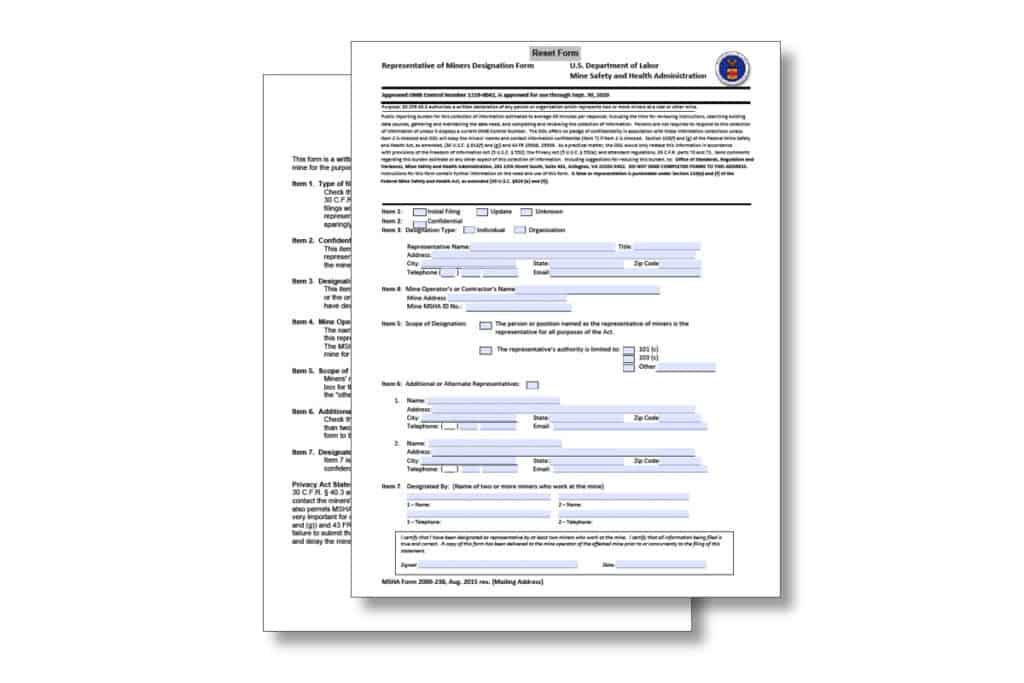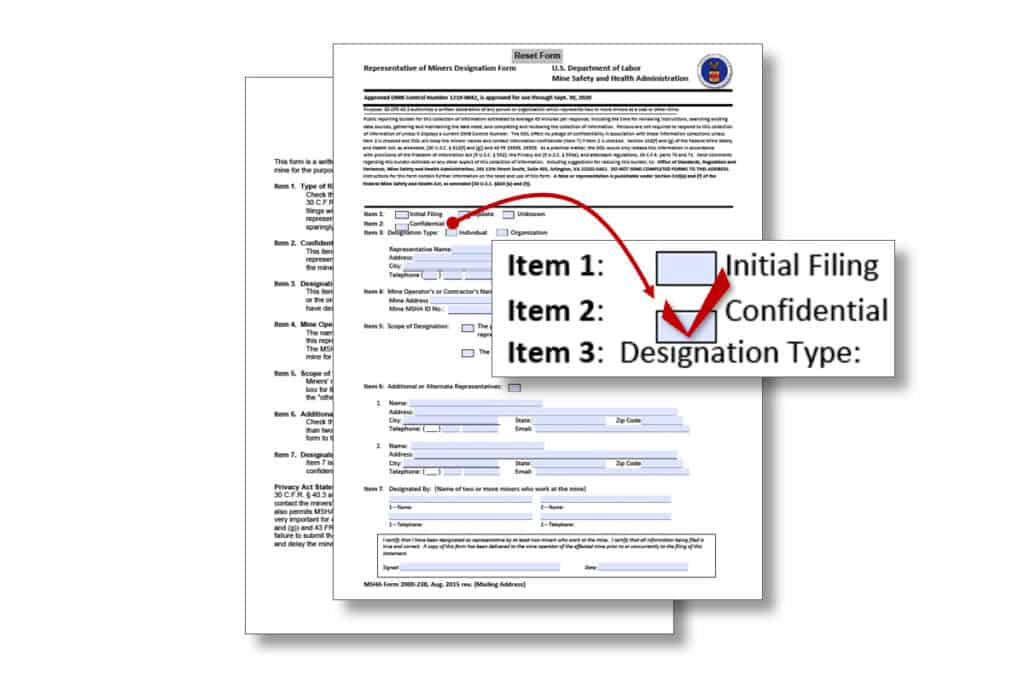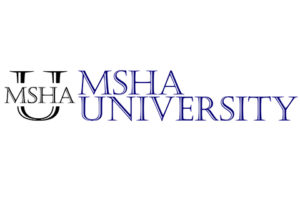The mission of the Mine Safety and Health Administration (MSHA) is to “prevent death, illness, and injury from mining and promote safe and healthful workplaces for miners.” Essentially, that’s about sending miners and mining contractors home to their families in one piece at the end of the day. MSHA works to accomplish this through legislation, education, enforcement, and cooperation with the mining industry. The “miners’ representative” is a critical role at every mine that helps MSHA do its job.
So, what is a miners’ representative and what do they do? A miners’ representative is any person or organization who represents two or more miners at a coal or other mine. The miner’s representative must be “designated by two or more miners to represent their interest during health and safety enforcement processes at their mine.”
It’s important to understand the value of this role and the part that it plays related the safety and health of miners and mining contractors. The miners’ representative is afforded certain responsibilities regarding communication between the mine and MSHA as well as the opportunity to personally observe during mine inspections. So, let’s go over some of the common questions I get asked about what a miners’ representative is and what they do.
What is a Miners’ Representative?
The Federal Mine Health and Safety Act of 1977 (The Mine Act) incorporated the idea of a representative of miners taking part in important aspects of mine safety. And in the Code of Federal Regulations (CFR) Part 40 – Representative of Miners, MSHA further defines a miners’ representative as:
“(1) Any person or organization which represents two or more miners at a coal or other mine for the purposes of the Act, and
(2) Representatives authorized by the miners, miners or their representative, authorized miner representative, and other similar terms as they appear in the Act.”
So, MSHA, via the Mine Act, created the role of miners’ representative and gives miners the right to appoint or designate a representative to act on their behalf in an official capacity in a variety of specific circumstances.
How Does Someone Become a Miners’ Representative?
A miners’ representative is basically chosen from among their fellow miners. And when two or more miners designate a person or organization as their representative, that person must file a 2000-238 Representative of Miners Designation Form with an appropriate MSHA district manager and provide a copy to the mine operator. Upon receipt by the mine operator, a copy of the information must be posted on the mine’s bulletin board and kept current.

This form includes the following information required by MSHA:
The names, addresses, and phone numbers of:
- The miners’ representative or organization
- The mine operator
- The mine (including MSHA ID)
- Any representative to serve in his or her absence
Statements that say:
- The person named as the representative of miners is the representative
- Copies of all information filed pursuant to this section have been delivered to the operator of the affected mine, prior to or concurrently with the filing of this statement
- This certifies that all information filed is true and correct followed by the signature of the representative of miners.
MSHA also allows for the designating miners to appoint the representative anonymously. This can be done by checking the “Confidential” box in Item 2 on the 2000-238 form.

This information can be submitted to MSHA in the following 3 ways:
- Providing the 2000-238 Form or conveying the information verbally to the appropriate MSHA district manager.
- Calling MSHA’s One Call Does It All number to provide the information.
- Filing the online version at MSHA.gov.
TIP! – Go to our RESOURCES page for links to MSHA contact info and all online forms.
What Does a Miners’ Representative Do?
MSHA expects that as a miners’ representative, you have experience and knowledge that will be helpful and valuable to their efforts in support of miner health and safety. So, MSHA extends miners’ representatives the right to be involved in a broad rand of enforcement activities, including inspections and conferences before and after inspections.
Miners’ representatives also have the right to accompany inspectors in:
- “Regular or spot inspections
- Inspections requested by the miners’ representative
- Inspections of especially hazardous mines
- Inspections in conjunction with accident investigations”
Miners’ representatives may also:
- Request research to be performed at the mine
- Request a safety and health conference
- Report hazardous conditions
- Request an inspection
- Assist with inspections
- Contest citations or orders
- Take part in the accident investigation process
- File discrimination complaints
- Request training records and other reports
- Petition for modifications to safety standards
- Take part in legal hearings
As the person or organization designated as the representative of miners, MSHA endows this role with a very broad right to access and involvement in a full range of enforcement activities and legal proceedings.
TIP! – Go to our RESOURCES page for links to MSHA’s Miners’ Representative Guide.
Responsibilities of Miners’ Representatives
While a miners’ representative has certain rights beyond other employees at a mine, they have additional responsibilities that may include:
- “Assisting mine operators to comply with mandatory health and safety standards and provisions of the Mine Act.
- Reporting accidents, health and safety hazards, and unsafe conditions.
- Complying with all Federal and State laws and regulations and company safety and health policies.
- Providing truthful statements and representations (orally or in writing) during any inspection or investigation, or on any applications, records, reports, plans, training certificates or other documents required to be kept or filed by the Act.
- Refraining from giving advance notice of an inspection conducted by MSHA.”
Who Do Miners’ Representatives Work With?
Aside from daily work expectations and communication with the mine operator, the miners’ representative may collaborate with a variety of MSHA personnel in the course of typical responsibilities of the role. MSHA personnel who may interact with the miners’ representative may include:
- District managers and assistant district managers – when filing forms and dealing with health and safety matters
- Education field services – during review and evaluation of the mine’s training programs
- Mine inspectors – during periodic or spot inspections, these authorized representatives of the Secretary of Labor have the right to enter any mine to conduct site inspections
- Field office supervisors – related to enforcement activities
- Technical specialists – when assisting with hazard controls or investigations
- Conference and litigation representatives – when contesting a citation
- Special investigators – in the event of discrimination complaint investigations
- Accident investigators – during investigations of fatal and nonfatal accidents
Assisting With Inspections
A miners’ representative is entitled to be paid during participation in inspections if they are an employee of the mine being inspected. If more than one representative accompanies a single inspector (or inspection group) during an inspection, the mine operator is only required to pay one of them. However, during inspections involving multiple inspectors gathering information separately, the mine operator is required to pay one representative accompanying each inspector.
While MSHA is not required to give advanced notice of inspections, inspectors may grant the mine a pre-inspection conference on the day of the inspection. A post-inspection conference may also be scheduled during which the inspector will provide:
- “A summary of all enforcement actions taken, including the root causes of hazards associated with violations.
- Any observations concerning conditions or practices.
- A discussion of accidents at the mine and the available results of any samples or surveys taken during the inspection.”
The miners’ representative has the right to be present for both pre and post-inspection conferences. However, the investigation may not be delayed due to the unavailability of a miners’ representative.
If any citations result from the inspection, the miners’ representative can request a safety and health conference within 10 days to review the enforcement actions.
The miners’ representative also has the right to contest any citations within 30 days.
And if any Federal Mine Safety and Health Review Commission hearings result, the miners’ representative has the right to participate.
Requesting Research
Miners’ representatives have the right to request research be conducted to determine if any substances or equipment at the mine could cause harm to miners. This research may involve sampling air and soil, conducting medical tests, reviewing injury reports, and interviewing miners.
Requests can be made to:
- MSHA
- Department of Health and Human Services (DHHS)
- National Institute of Occupational Safety and Health (NIOSH)
Filing Complaints and Reporting Hazards, Unsafe Conditions, and Accidents
Miners’ representatives have the right and responsibility to file a discrimination complaint within 60 days of the alleged discriminatory act if they “believe that discrimination has occurred as a result of exercising your rights.” Complaints can be filed using the 2000-123 and 2000-124 forms in person, by phone, or by mail.
Miners and their representatives can also file a hazardous condition complaint in the event that they observe a “hazardous condition, imminent danger, violation of a mandatory safety or health standard or violation of the Mine Act.”
MSHA categorizes mine accidents into four types – Fatal, nonfatal, non-injury, and unknown.
Participating in Investigations
MSHA conducts accident investigations for two main reason – to determine root cause and to utilize the information to prevent similar accidents.
After an initial meeting to discuss the investigation process, MSHA investigates accidents in three phases:
- On-site examination of the accident scene and relevant records
- Witness interviews
- Equipment or materials analysis and testing
Miners’ representatives may accompany investigators and observe during all phases of the investigation, even during confidential witness interviews and analysis of evidence. Representatives can further participate in the close-out conference, during which investigators review preliminary findings and discuss any ongoing investigation procedures.
Upon completion of the final investigation report, an authorized MSHA representative will personally deliver the report to the victim’s family (in the case of fatality), the mine operator, any associated labor organization, and the miners’ representative.
Petitioning for Modification of Standards
Miners’ representatives have the right to challenge a new standard within 60 days of publication of the standard on the grounds of:
- The belief that the proposed standard will adversely affect or diminish the safety of miners, or
- There is a feasible alternative that will provide equivalent protection to miners.
TIP! – Go to our RESOURCES page for links to MSHA’s Miners’ Representative Guide, where you’ll find sample templates of petitions to contest standards.
Involvement in Civil Penalties and Litigation Procedures
Miners’ representatives have the right to take part in the enforcement and contesting of civil penalties and litigation procedures. This includes informally taking part in litigation conferences, potentially presenting additional information related to the penalty under litigation.
Obtaining Information and Records
Miners’ representatives have the right to receive and examine a variety of records, including:
- Citations
- Notices
- Orders
- Reports
- HazCom records
- Training certificates
- Noise exposure notices
- Toxic materials exposure records
If a miners’ representative works at a mine with a pattern of violation (POV), the representative is entitled to receive:
- A copy of MSHA’s POV notice to the mine
- A copy of the mines Corrective Action Program (CAP)
- Notification of MSHA’s approval status of the CAP
Miners’ representatives also have the right to review and inspect other types of records, documents, and plans for underground mines, including:
- Roof control plans
- Mine maps
- Emergency response plan
- Emergency evacuation, training and drills
- Ventilation plans
- Examinations of hazardous conditions, ventilation, electrical equipment, etc.
- Ground control
- Limit on exposure to diesel particulate matter – posting of application
Representatives do not have the authority or right to participate in certain audits that involve reviewing the personal medical records of others.
Miners’ Representative Protections
Miners and their representatives are protected from discrimination or retaliation for “engaging in safety and/or health related activities, such as identifying hazards, asking for MSHA inspections, or refusing to engage in an unsafe act.”
Termination of Representative Designation
The designation of a person or organization as a miners’ representative can be terminated in the following two ways:
- If the representative becomes unable to comply with the requirements of the role, they can file a statement with the MSHA district manager to terminate the designation.
- MSHA may terminate the designation of the representative for either being unable to comply or acting out of compliance with the requirements of the role.
Related Questions
What Are Miners’ Rights?
Miners have certain basic rights bestowed upon them by MSHA through the Mine Act in support of creating a safe work environment. This includes the rights to:
- “File or make a complaint of an alleged danger or safety or health violation to a Federal or State agency, a mine operator, an operator’s agent or a miner’s representative.
- Participate in proceedings under the Act such as: testifying, assisting, or participating in any proceeding instituted under the Act, or filing a complaint with the Federal Mine Safety and Health Review Commission.
- A medical evaluation or to be considered for transfer to another job location because of harmful physical agents and toxic substances. (For example: a coal miner has the right to a chest x-ray and physical examination for black lung disease [pneumoconiosis] and potential transfer to a less dusty position if the miner has a positive diagnosis.)
- Withdraw yourself from the mine for not having the required health and safety training.
- Refuse to work in unsafe or unhealthy conditions. NOTE: You must notify the operator of the condition and give them an opportunity to address the situation.
- Exercise any statutory rights afforded by the Act.”
Miners also have the rights to:
- Be paid during certain periods of time when the mine has had to close
- Health and safety training during normal working hours
What Are Miners’ Responsibilities?
In addition to certain rights, miners have responsibilities placed on them by the Mine Act. Those responsibilities include:
- Complying with all laws, regulations, and mine safety policies
- Notifying the mine operator when refusing to work in unsafe conditions
- Providing truthful statements and representations to any authorized representative of the Secretary of Labor (MSHA inspector) during inspections, investigations, hearings, or other means of documentation
What Is Protection From Discrimination?
Miners have the right to be protected against acts of discrimination when exercising their rights under the Mine Act. Protected acts include, but are not limited to:
- “File or make a complaint of an alleged danger or safety or health violation to a Federal or State agency, a mine operator, an operator’s agent, or a miners’ representative.
- File a complaint with the Federal Mine Safety and Health
- Review Commission, testify, or otherwise participate in any proceeding.
- Become involved in any inspection or investigation conducted under the Act.
- Have a medical evaluation or are considered for transfer to another job location because of harmful physical agents and toxic substances. For example, coal miners have the right to a chest x-ray and physical examination for black lung disease (pneumoconiosis) and potential transfer to a less dusty position if the diagnosis is positive.
- Withdraw from the mine for not having the required health and safety training.
- Refuse to work in conditions you reasonably believe to be unsafe or unhealthy.
- Use any statutory right given by the Act, such as being paid as a miners’ representative while accompanying an MSHA inspector during an inspection or the right to be paid while receiving required training under the Act.”

